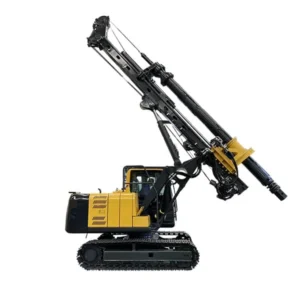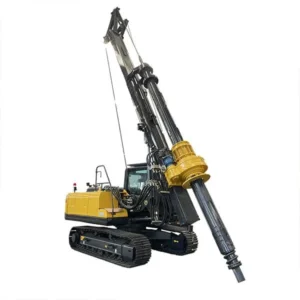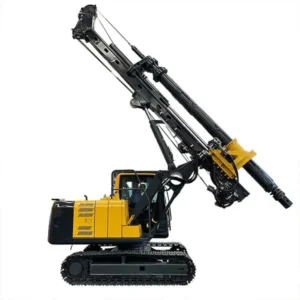Welcome to My Blog!
Before we dive into the content, I’d love for you to join me on my social media platforms where I share more insights, engage with the community, and post updates. Here’s how you can connect with me:
Facebook:https://www.facebook.com/profile.php?id=100066759548969
Now, let’s get started on our journey together. I hope you find the content here insightful, engaging, and valuable.
Perkenalan: what is rotary drilling rig?
Rotary drilling rigs are a cornerstone of modern drilling operations, widely used in various industries such as oil and gas, mining, and construction. But what exactly is a rotary drilling rig, and how does it work? This comprehensive guide will delve into the intricacies of rotary drilling rigs, explaining their functions, components, and applications. By the end of this article, you’ll have a clear understanding of what a rotary drilling rig is and how it contributes to the drilling process.
What Is a Rotary Drilling Rig?

Understanding the Basics of Rotary Drilling Rigs
To answer the question, “What is rotary drilling rig?” it’s essential to start with the basics. A rotary drilling rig is a piece of equipment used to drill boreholes or wells in the earth. These rigs are versatile and can be used for a variety of drilling tasks, from drilling water wells to extracting oil and gas. The primary function of a rotary drilling rig is to cut through rock formations to create a borehole that can be used for resource extraction or geological exploration.
Key Components of a Rotary Drilling Rig
A rotary drilling rig consists of several critical components, each playing a vital role in the drilling process. These include:
- Drill Bit: The drill bit is the cutting tool that is attached to the end of the drill string. It is responsible for breaking up the rock and sediment as the rig drills deeper into the earth.
- Drill String: The drill string is a column, or string, of drill pipes that transmit drilling fluid and rotational power from the surface to the drill bit.
- Rotary Table: The rotary table is a mechanical device on the rig floor that provides the rotational force to the drill string.
- Mud Pump: The mud pump circulates drilling fluid (also known as drilling mud) down through the drill string and back up the borehole to remove cuttings and stabilize the wellbore.
- Derrick or Mast: The derrick is a tall structure that supports the drill string and allows it to be raised or lowered into the borehole.
Types of Rotary Drilling Rigs
Rotary drilling rigs come in various types, each designed for specific drilling conditions and tasks. The two primary types of rotary drilling rigs are:
- Land Rigs: These rigs are used for onshore drilling and are typically mounted on trucks or trailers for mobility. They are used in oil fields, construction sites, and other onshore locations.
- Offshore Rigs: These rigs are designed for drilling in offshore environments, such as in oceans and seas. They are usually mounted on platforms or ships and are capable of drilling in deep water.
How Does a Rig Pengeboran Putar Work?
The Drilling Process Explained
To understand how a rotary drilling rig works, it’s important to break down the drilling process into its key steps:
- Preparation: Before drilling begins, the rig is set up, and the necessary equipment is assembled. The drill site is prepared, and safety measures are put in place.
- Spudding In: The drilling process starts with “spudding in,” where the drill bit is lowered into the borehole, and drilling begins. The rotary table or top drive provides the rotational force needed to turn the drill string and the drill bit.
- Drilling Fluid Circulation: As drilling progresses, drilling fluid is pumped down through the drill string. This fluid serves multiple purposes, including cooling the drill bit, removing cuttings from the borehole, and stabilizing the wellbore walls.
- Penetration: The drill bit continues to cut through the rock formations, creating a borehole. The rate of penetration (ROP) depends on factors such as the type of rock, the weight on the bit, and the rotational speed.
- Casing and Cementing: As the borehole is drilled, casing (a steel pipe) is inserted into the hole to prevent it from collapsing. The casing is then cemented in place to secure it.
- Completion: Once the desired depth is reached, the drilling process is completed. The borehole is prepared for its intended purpose, whether it’s for resource extraction or geological exploration.
The Role of Drilling Fluid in Rotary Drilling
Drilling fluid, also known as drilling mud, is a crucial component of the rotary drilling process. It serves several essential functions, including:
- Cooling and Lubricating the Drill Bit: Drilling fluid helps to cool and lubricate the drill bit, preventing it from overheating and wearing out too quickly.
- Carrying Cuttings to the Surface: The fluid circulates through the drill string and carries rock cuttings to the surface, where they can be removed from the drilling site.
- Stabilizing the Borehole: Drilling fluid helps to maintain pressure in the borehole, preventing it from collapsing and ensuring the walls remain intact.
Table: Comparison of Rotary Drilling Rig Components
| Component | Function | Importance |
|---|---|---|
| Drill Bit | Cuts through rock formations | Critical for borehole penetration |
| Drill String | Transmits rotational power and drilling fluid | Essential for drilling operation |
| Rotary Table | Provides rotational force to the drill string | Key to enabling drilling |
| Mud Pump | Circulates drilling fluid through the system | Vital for cooling, cutting removal, and stabilization |
| Derrick/Mast | Supports the drill string | Necessary for raising and lowering the drill string |
Advantages and Disadvantages of Rotary Drilling Rigs

Advantages of Using Rotary Drilling Rigs
- Efficiency: Rotary drilling rigs are highly efficient, capable of drilling deep boreholes quickly and effectively.
- Keserbagunaan: These rigs can be used for a wide range of drilling tasks, from water wells to oil extraction.
- Precision: Rotary drilling allows for precise control over the drilling process, ensuring accurate borehole placement.
Disadvantages and Challenges
- Biaya: The cost of operating a rotary drilling rig can be high, especially in remote or challenging environments.
- Dampak lingkungan: Drilling operations can have a significant environmental impact, including land disturbance and the potential for spills.
- Complexity: Rotary drilling rigs are complex machines that require skilled operators and regular maintenance.
Conclusion: what is rotary drilling rig?
In conclusion, understanding “what is rotary drilling rig” and “how does it work” provides valuable insight into one of the most critical tools in modern drilling operations. Rotary drilling rigs are essential for a variety of applications, from resource extraction to geological exploration. Their efficiency, versatility, and precision make them indispensable in many industries. However, it’s important to consider the costs, environmental impact, and complexity associated with their use. By understanding these factors, industry professionals can make informed decisions about the use and management of rotary drilling rigs.
Pertanyaan Umum
What is rotary drilling rig, and how does it function?
A rotary drilling rig is a machine used to drill boreholes by rotating a drill bit to cut through rock formations. It functions by using a rotating drill string that transmits drilling fluid and power to the bit.
What is rotary drilling rig used for in the oil and gas industry?
Rotary drilling rigs are primarily used in the oil and gas industry to drill wells for the extraction of crude oil and natural gas.
What is rotary drilling rig, and what are its main components?
A rotary drilling rig consists of several key components, including the drill bit, drill string, rotary table, mud pump, and derrick. These components work together to drill through the earth’s surface.
How does the drilling fluid work in what is rotary drilling rig?
In a rotary drilling rig, drilling fluid (or mud) is circulated through the drill string to cool the bit, remove cuttings, and stabilize the borehole.
What is rotary drilling rig, and what types of drilling tasks can it perform?
Rotary drilling rigs are versatile and can perform a variety of drilling tasks, including drilling for water, oil, gas, and geothermal energy, as well as geological exploration.
What is rotary drilling rig, and how does it differ from other drilling methods?
A rotary drilling rig uses a rotating drill bit to penetrate the earth, which differs from other methods like percussion drilling, which involves pounding or hammering to break rock.
What is rotary drilling rig, and what are its advantages?
The advantages of a rotary drilling rig include its efficiency, ability to drill deep boreholes quickly, and versatility in different drilling environments.
What is rotary drilling rig, and what are the environmental considerations?
Rotary drilling rigs can have environmental impacts, such as land disturbance and potential for spills. Proper management and mitigation strategies are necessary to minimize these effects.
What is rotary drilling rig, and how do you choose the right one for a project?
Choosing the right rotary drilling rig depends on factors such as the depth of the borehole, the type of rock formations, and the specific requirements of the drilling project.
What is rotary drilling rig, and what maintenance is required to ensure optimal performance?
Regular maintenance of a rotary drilling rig includes checking the drill bit, lubricating the rotary table, inspecting the drill string, and ensuring the mud pump is functioning properly.










-150x150.webp)
